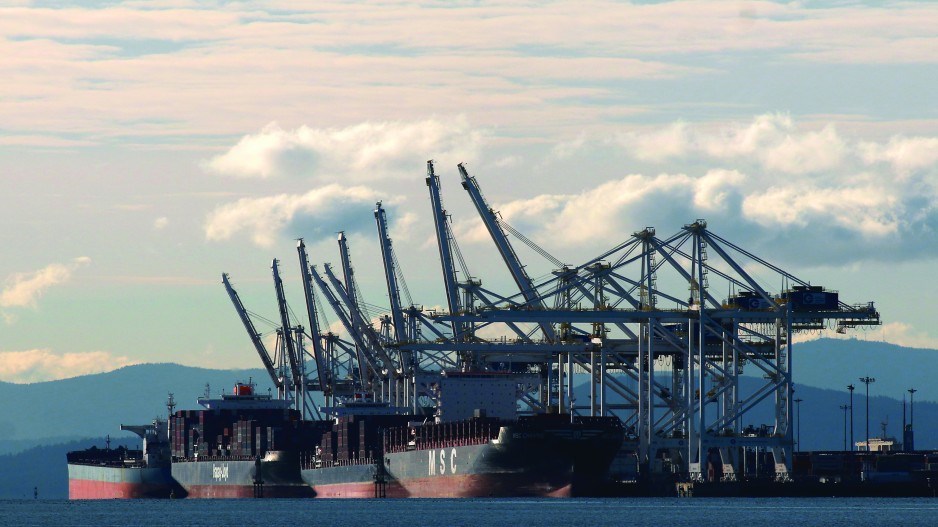When will it make landfall at B.C.
The answers to those questions about widespread automation at marine container terminals vary; the inevitability of automation’s arrival does not. It is coming, but its impact on port productivity and careers in cargo handling is open to debate.
Its future incorporation in B.C.
Meanwhile, the threat of automation has already sparked a confrontation at a major port competitor to Vancouver and Prince Rupert.
The International Longshore and Warehouse Union (ILWU) and the International Transport Workers’ Federation are fighting plans by an affiliate of the world’s largest container shipping company to automate part of Pier 400 in Los Angeles.
The unions oppose what they see as the huge social and financial costs that will be borne by their membership from any significant automation of containerized cargo movement.
In a Random Lengths News story filed earlier this year on the Pier 400 controversy, ILWU leaders argued that automation was not good for
Some analysts believe that a wholesale shift to automation might also not be that great for container terminal productivity.
However, major West Coast ports know that technological change is on the near horizon in a sector that has traditionally been slow to commit the huge investment needed to incorporate digital and other technology in its operations.
In a recent discussion with Let’s Talk Supply Chain podcast host Sarah Barnes-Humphrey, the deputy executive director of administration and operations for the Port of Long Beach (POLB) said that technology is fundamental to
Noel Hacegaba pointed out that POLB is close to reaching its physical capacity and therefore needs to maximize the efficiency of its current footprint.
Incorporating new supply chain technology in a global sector whose major pieces are interdependent but not necessarily connected, he said, is challenging but vital to the port’s future development and its ability to compete with major ports in Mexico and B.C.
Long Beach and the adjacent Port of Los Angeles make up the San Pedro Bay complex, which is the world’s ninth-busiest marine cargo hub.
In Vancouver, ILWU Canada president Robert Ashton has previously declined to comment on what his union considers to be the most contentious automation issues in its current contract negotiations with the BC Maritime Employers Association.
He has said only that ILWU Canada is “concerned about anything that could harm a worker’s daily life.”
In some cases, new technology might improve that life.
GCT Global Container Terminals Inc.’s rail
According to Canada’s largest maritime employer, the $300 million project was the first semi-automated initiative of its kind in the country and has increased GCT Deltaport’s container cargo capacity 33% and its ability to move
But what did it do for dock workers?
GCT president and CEO Doron Grosman provided an
Speaking with workers after the new crane and rail technology was operating, he said a 20-year GCT Deltaport veteran told him he was now having fun at his job.
Why?
“He said, ‘I used to come to work and have to climb a ladder and sit in a box all day; it was cold; it was lonely; if I had to pee I had to go back down [the ladder]. I ate lunch over there; I had nothing. Now I’m sitting in a control room; I’m sitting with six other guys. We
That new technology might make working conditions better, but Lars Jensen, the CEO of Copenhagen-based SeaIntelligence Consulting, said inevitably it will reduce the number of container terminal jobs.
Automation will also change the nature of those jobs and the training required to do them. Blue collar will shift to white smock.
As a simple example, Jensen said, if a terminal today has 100 workers hired to drive ground vehicles around and they are replaced with robots, “you eliminate those jobs, but then you need highly qualified engineers to maintain those vehicles, but [the terminal] won’t need 100 trained engineers to do that. So there will definitely be new jobs, but they won’t be as plentiful as the old jobs.”
Automation, which is extremely expensive for container terminals to install, might also not increase port productivity significantly.
Jensen pointed out that there are several logistic restrictions that weigh against the advantages of automation at a container terminal. For example, unloading a container from a ship with a crane “does not go any faster whether it’s a robot or a human moving the crane. You can’t speed up the crane. You would only wreck something.… If you have an experienced crane driver, he is every bit as good as a robot.”
He added, however, that while automation might not make moving containers more efficient, it would deliver more stable productivity.
“With automated solutions, there is less variability between ‘Yes, this was a good day; yes, this was a bad day.’ So you can’t say that if we put in
A McKinsey & Co.
The Future of Automated Ports found that, while operating expenses at automated
That results in lower returns on invested capital than in other industries.
However, the report concluded that, if planned and executed well, automated
Automation’s value, it said, “includes not only cost
Jensen said there are few fully automated ports in the world and that retooling infrastructure at established ports to make it fully automated is not the answer, because “going 100% automated is not necessarily cost efficient.”
He said the answer is to look at all areas of a terminal’s cost and productivity fundamentals to determine where automation would deliver the most savings and efficiency gains.
“It’s as simple as that.”
He said if automation does not make a terminal money and succeeds only in upsetting a unionized workforce, “What’s the purpose of it?” •
@timothyrenshaw




